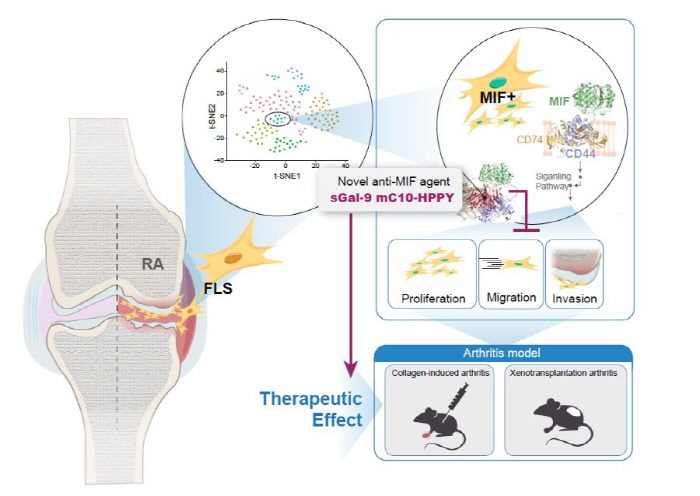New treatments for rheumatoid arthritis opened up...Suppression of synovial cells that conventional drugs have not caught
|
A number of researchers participated in the study, including Professor Yoo Seung-ah (co-corresponding author), Professor Kim Wan-wook (co-corresponding author), Dr. Lee Mi-ryeong (co-first author), and Dr. Nam Min-kyung (co-first author), and used the patient's actual tissue and animal models to prove scientific evidence.
Rheumatoid arthritis is a typical autoimmune disease caused by the immune system attacking the body. In particular, the thin membrane surrounding the joint, that is, synovium (滑膜), overproliferates and causes inflammation, and over time, it destroys cartilage and bones.
Currently, widely used treatments focus on suppressing excessive responses or inflammatory signals from immune cells. However, complete treatment is not easy because synovial cells continue to maintain aggressive properties inside the joint.
The research team used a cutting-edge technique called single-cell transcriptome analysis. This is a way to look into how each cell's genes work, which is useful for finding the root cause of the disease.
Through this analysis, the researchers identified the world's first particularly aggressive subtype among synovial cells of rheumatoid arthritis patients. These cells had the characteristic of making abnormally large amounts of protein called macrophage migration inhibition factor (MIF). The research team named it MIF-high FLS (fibroblast-like synoviocytes).
MIF-high FLS had an abnormality in the function of mitochondria, called energy power plants in cells, and endoplasmic reticulum to process and transport proteins. Because of this, it has been found to be the main culprit of excessive proliferation, movement within the joint, and destruction of bones and cartilage.
The research team used Galectin-9 (recombinant stabilized Galectin-9), a recombinant stabilization protein developed by G-BioLogics. This substance is a stabilizing form of proteins originally present in the human body and plays an important role in regulating inflammatory responses and cell-to-cell signals.
In experiments, galectin-9 blocked the MIF and its receptor, the CD74/CD44 pathway. In other words, synovial cells activate themselves and increase aggression 'Switch' has been turned off. As a result, synovial cell proliferation, migration, and invasion were clearly suppressed, and joint destruction was also noticeably reduced.
In addition, in SCID mouse models (immunodeficiency mice) and collagen-induced arthritis (CIA) models in which patient cells were transplanted, galectin-9 prevented cartilage and bone damage and significantly alleviated arthritis symptoms. This means that the therapeutic effect has already been substantially validated at the animal testing stage.
Representative treatments used so far, such as Enbrel and Tofacitinib, have mainly focused on suppressing inflammatory signals or immune cells. However, Galectin-9 goes one step further and directly suppresses the synovial cells themselves, which are the key etiologies of arthritis.
In particular, even if a patient reaches clinical remission (with few symptoms) with drug treatment, synovial cells still maintain aggression and continue joint damage. This study is significant in that it presents a new treatment strategy to overcome these limitations.
Professor Yoo Seung-ah confirmed the possibility of directly suppressing the underlying causative cells of rheumatoid arthritis through this study"We will make efforts to contribute to actual patient treatment by developing it into future clinical research."," he said.
Professor Kim Wan-wook evaluated "Rheumatoid arthritis is a disease that requires lifelong management for patients, but it is very encouraging that a new approach targeting synovial cells has been proposed" and "This study is of great significance both academically and in terms of patient treatment strategies."
|
This article was translated by Naver AI translator.





